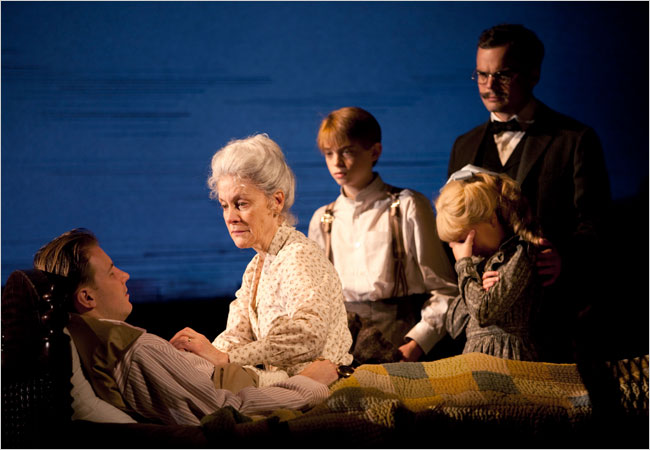This has been a wonderful week for New York-area theater, so busy that it took two columns in The Wall Street Journal for me to get it all in. Today I review two openings, the New York premieres of the first installment of Horton Foote’s The Orphans’ Home Cycle and Sarah Ruhl’s In the Next Room or the vibrator play. The first is a masterpiece, the second a piece of…well, something else altogether. Here’s an excerpt.
* * *
Horton Foote, who died in March at the age of 92, had to wait until the very end of his life to win general recognition as one of America’s greatest playwrights. The tide was turned by a sterling pair of Off-Broadway revivals, the Signature Theatre Company’s 2005 production of “The Trip to Bountiful” and Primary Stages’ 2007 production of “Dividing the Estate,” that opened the eyes of a new generation of theatergoers to Foote’s low-keyed mastery. When “Dividing the Estate” transferred to Broadway the following year, he scored his first commercial success on the New York stage–just in time for him to revel in it. Would that Foote could have lived to attend the New York opening of the first part of “The Orphans’ Home Cycle,” co-produced by Signature and Connecticut’s Hartford Stage, where all three installments were seen earlier this year. It will, I suspect, be remembered as the most significant theatrical event of the season, the kind of show you tell your grandchildren that you saw.
 Created by Foote at the suggestion of Michael Wilson, the artistic director of Hartford Stage and the director of this production, “The Orphans’ Home Cycle” is a triptych carved out of a cycle of nine plays originally written between 1974 and 1997. It’s the story of a quarter-century in the life of a Texas family, and the family is Foote’s own, a flock of displaced people who are uprooted, scattered and damaged by the coming of modernity. The title alludes to Marianne Moore’s poem “In Distrust of Merits”: The world’s an orphans’ home. Shall/we never have peace without sorrow? At the center of the saga is Horace Robedaux, a fictionalized version of Foote’s real-life father (beautifully played as a child by Dylan Riley Snyder, as a teenager by Henry Hodges and as an adult by Bill Heck). Cast adrift by the death of his own alcoholic father and the remarriage of his mother to a resentful man who loathes his stepson, Horace becomes a stranger in a familiar land, searching for a peace that continually eludes him….
Created by Foote at the suggestion of Michael Wilson, the artistic director of Hartford Stage and the director of this production, “The Orphans’ Home Cycle” is a triptych carved out of a cycle of nine plays originally written between 1974 and 1997. It’s the story of a quarter-century in the life of a Texas family, and the family is Foote’s own, a flock of displaced people who are uprooted, scattered and damaged by the coming of modernity. The title alludes to Marianne Moore’s poem “In Distrust of Merits”: The world’s an orphans’ home. Shall/we never have peace without sorrow? At the center of the saga is Horace Robedaux, a fictionalized version of Foote’s real-life father (beautifully played as a child by Dylan Riley Snyder, as a teenager by Henry Hodges and as an adult by Bill Heck). Cast adrift by the death of his own alcoholic father and the remarriage of his mother to a resentful man who loathes his stepson, Horace becomes a stranger in a familiar land, searching for a peace that continually eludes him….
Not having seen the second or third parts, I can’t yet evaluate the total effect of the cycle as a whole, but “The Story of a Childhood” has the narrative sweep that you look for in major novels, coupled with the electric immediacy that only live theater can supply….
Sarah Ruhl writes retchingly coy plays that pretend to be transgressive–a sure-fire recipe for success of a sort. “In the Next Room or the vibrator play” (trendy capitalization and punctuation by Ms. Ruhl, not me) is an all-too-typical example of her method. It’s a fictionalized history play about a 19th-century American physician (Michael Cerveris) who discovers that “hysterical” women experience miraculous recoveries when he induces “paroxysms” by stimulating their nether regions with his brand-new invention, an electric vibrator….
“In the Next Room” is a sentimental wallow studded with sniggering jokes that too often appear to be made at the expense of Ms. Ruhl’s innocent characters, none of whom is believably Victorian in speech or carriage. The result is the theatrical equivalent of a jelly donut with vinegar-flavored frosting…
* * *
Read the whole thing here.
Terry Teachout on the arts in New York City
An ArtsJournal Blog
